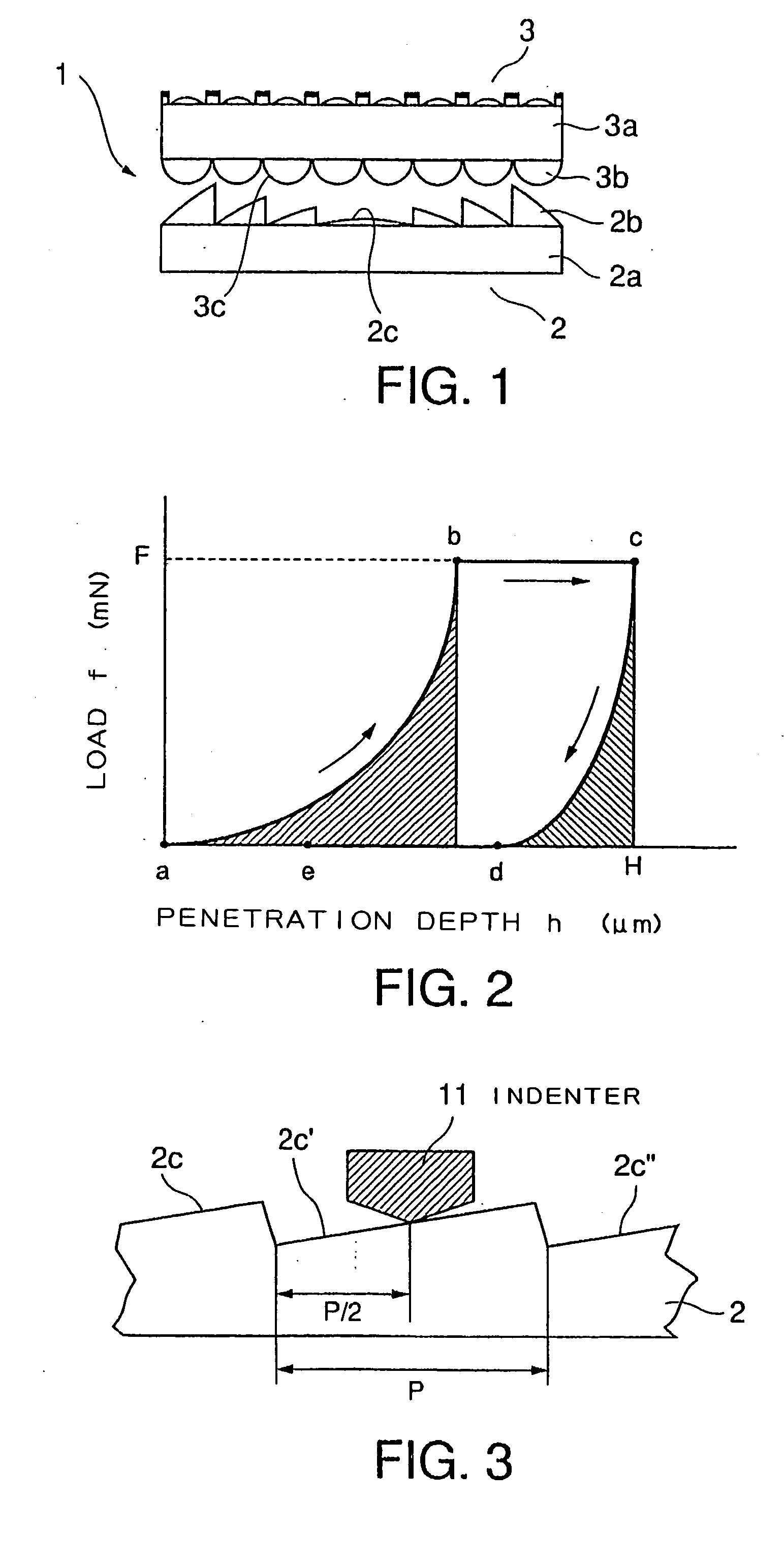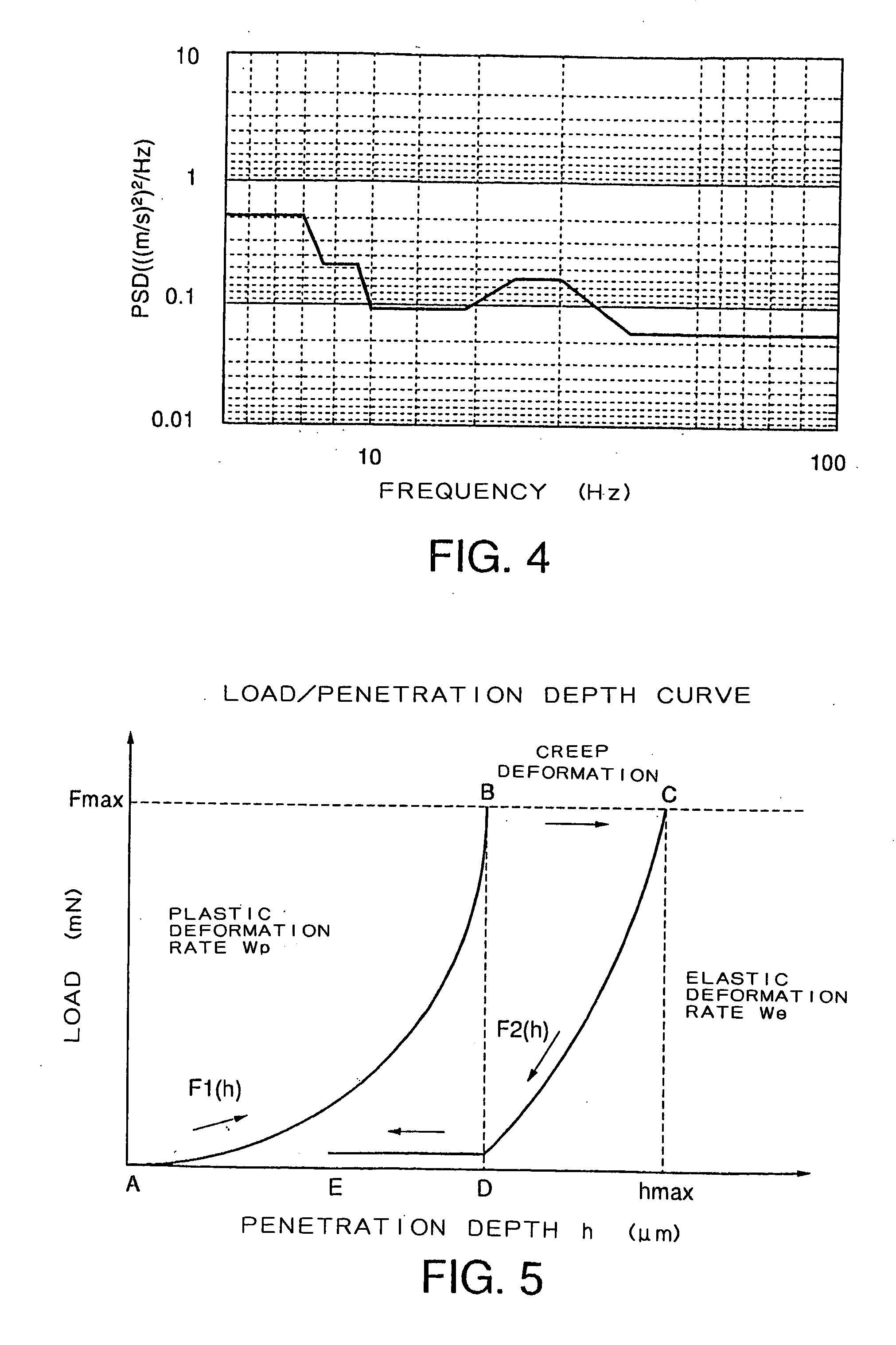[0016] As a result of extensive and intensive studies with a view to solving the above problems of the prior art, it was found that friction resistance can be improved by imparting elastomeric restorability (
restoring force, restoring speed) to a cured resin having predetermined optical characteristics and that, even when a resin composition, into which a large amount of a
benzene ring has been introduced, has been used for desired
refractive index development purposes, there is a property region which develops rigidity and
rubber elasticity. Specifically, it was found that the above problems of the prior art can be solved by using, in an optical element, a resin composition, in which the
glass transition temperature, the
coefficient of friction, the equilibrium modulus of elasticity, the storage-modulus, the loss tangent, the restoring speed, and the deformation level are in predetermined respective ranges and, in addition, there are a predetermined relationship between elastic deformation rate and compression modulus of elasticity and a predetermined relationship between compression modulus of elasticity and
creep deformation.
[0018] Preferably, the above optical element resin composition satisfies a relationship represented by formula We >−0.0189E+34.2 wherein We represents elastic deformation rate in %; and E represents compression modulus of elasticity in Mpa. The use of this resin can suppress the collapse of lenses caused by mutual compression of the lens surfaces in the
projection screen. Specifically, the optical element using the resin composition according to the present invention, even when brought into intimate contact with a warped
lenticular lens, does not undergo collapse of the concave / convex parts on its lens surface. In a region of We≦−0.0189E+34.2, restorability from collapse of the lens surfaces caused by mutual compression is poor.
[0019] More preferably, the resin composition satisfies a relationship represented by formula V≧0.178DM−0.852 wherein V represents restoring speed in μm / sec; and DM represents maximum deformation level in μm. Satisfying a relationship represented by formula V≧0.112DM−0.236 is particularly preferred. When the resin composition used satisfies the above relationship between the maximum deformation level and the restoring speed, the collapse of lenses caused upon contact with a
lenticular lens can be suppressed. Further, specifying the relationship between the deformation level of the resin and the speed of restoration of the deformation so as to fall in a predetermined range can reduce friction between lenses caused by periodical
impact during vibration of the lenses.
[0020] In a preferred embodiment of the present invention, the optical element resin composition satisfies a relationship represented by formula V≧0.858R−0.644 wherein V represents restoring speed in μm / sec; and R represents
residual deformation level in μm. When a resin composition, in which the relationship between the restoring speed and the
residual deformation level satisfies a requirement of the above relational expression, is used, the collapses of the lenses caused by mutual compression of the lens surfaces can be suppressed. Specifically, a
Fresnel lens can be provided which, even when brought into intimate contact with a warped
lenticular lens, does not undergo collapse of the lens. Further, in this
Fresnel lens, even when once the lens is deformed as a result of stacking in a combination with a lenticular lens, upon release of the load (upon incorporation in TV), the lens shape can be restored to the original shape.
[0022] In a particularly preferred embodiment, the optical element resin composition according to the present invention has a storage modulus of not more than 2.96×1010
dyne / cm2 at −20° C. and a loss tangent of not less than 0.02 at −20° C. In the resin having the above property values, the quantity of energy stored in the vibration is small, the proportion of loss as
thermal energy is high, and, thus, the vibration can easily be relaxed. Therefore, in the lens using this resin, friction caused by
dynamic contact between lenses can easily be avoided.
[0023] In a preferred embodiment of the present invention, the loss area in a temperature range of −20 to 50° C. in a curve for dependency of loss tangent upon temperature is 20° C. or above. In particular, the loss area in a temperature range of −20 to 50° C. in a curve for dependency of loss tangent upon temperature is preferably 20 to 43.2° C., particularly preferably 20 to 31.7° C. The use of the resin composition having properties falling within the above numerical
property value range is advantageous in that, upon
exposure to vibration with various frequencies during transportation of the
projection screen, the
vibrational energy is converted to
thermal energy. Therefore, very effective fundamental vibration proof properties can be provided. In the case of a resin composition having a large loss area, since polyrelaxation of
molecular motion occurs, the restorability of the resin can be improved and, thus, the deformation of the resin caused by the
external pressure can be reduced over a wide temperature range.
 Login to View More
Login to View More 


